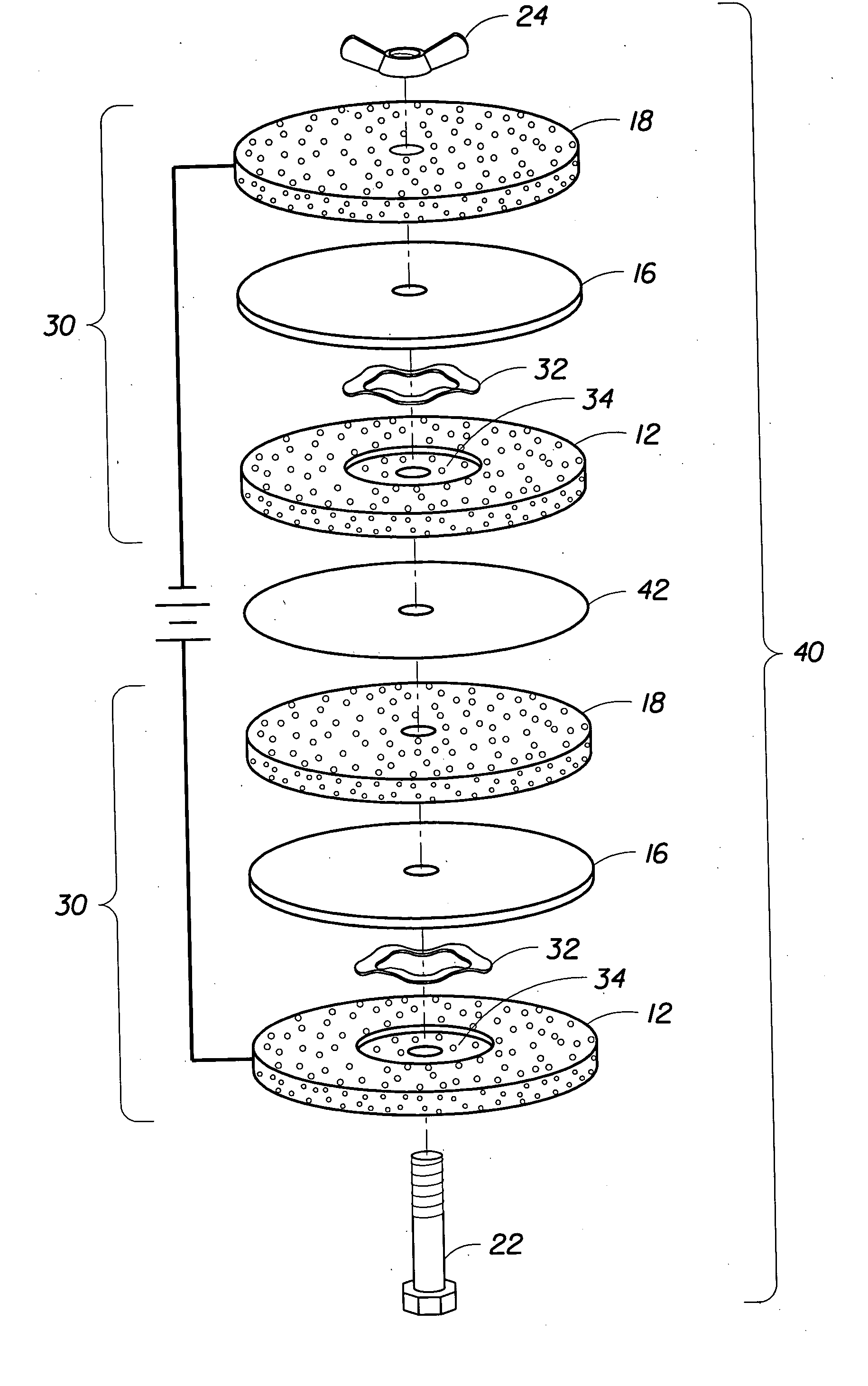Electrochemical apparatus with retractable electrode
a technology of electrochemical apparatus and retractable electrode, which is applied in the direction of cell components, cell component details, multi-stage water/sewage treatment, etc., can solve the problems of reducing the yield of ozone, affecting the efficiency of electrochemical process,
- Summary
- Abstract
- Description
- Claims
- Application Information
AI Technical Summary
Problems solved by technology
Method used
Image
Examples
example 1
[0106] Porous titanium substrates, namely pieces of a woven titanium cloth (150×150 per inch, clean, 0.0027″ wire diameter, twill weave, 35.4% open area; Unique Wire Weave, Hillside, N.J. 07205), were pretreated and subsequently electroplated with β-lead dioxide. A number of these β-lead dioxide-coated titanium cloths were used in an electrochemical cell incorporating a commercially available proton exchange polymer membrane (sold under the trade name Nafion®, by E.I. du Pont de Nemours and Company, Wilmington, Del. 19898), which is a perfluorosulfonic acid solid polymer electrolyte, and tested using an apparatus described in U.S. Pat. No. 5,460,705 commonly owned by the applicant. In some cases, the β-lead dioxide-coated titanium cloths were mechanically pressed against one side of a proton exchange membrane sample simply by means of clamping together the endplates of the electrochemical cell. In other cases, the β-lead dioxide-coated titanium cloths were hot pressed onto one side ...
example 2
[0111] Another type of porous titanium substrates, namely sintered porous titanium substrates derived from the sintering of regular shaped titanium powders (e.g., spheres) or irregular shaped titanium particles under high temperature and pressure in an inert gas environment and available from Astro Met, Inc., Cincinnati, Ohio 45215 (100-80 / 120 and 100-45 / 60; 5.5″×11″×0.050″ sheets) and Mott Corporation, Farmington, Conn. 06032 (Mott 40 micron and Mott 20 micron), respectively, were used. The sintered porous titanium substrates were pretreated and subsequently electroplated with β-lead dioxide as described above for the titanium cloth samples. The β-lead dioxide-coated sintered porous titanium substrates were mechanically pressed against one side of samples of a proton exchange polymer membrane (Nafion®) on clamping the endplates of an electrochemical cell together. They were tested under identical conditions to those utilized for the α-lead dioxide-coated titanium cloth anodic subst...
example 3
[0113]β-lead dioxide coated sintered porous titanium substrates were subjected to multiple applied current density “on” / “off” events, leading to a gradual lowering of the ozone current efficiency. For coated substrates that were maintained continuously in compression with the proton exchange polymer membrane, both in the case when the applied current density was “on” and when the applied current density was “off,” the effect of four applied current density “on” / “off” events on the ozone current efficiency for an electrochemical cell initially producing ozone at a current efficiency of 14.5 (corresponding to a concentration of 14.5 wt %) is presented in FIGS. 17A-B. It was further observed that the dramatic effect of applied current density “on” / “off” events on ozone current efficiency was more pronounced for electrodes having low electrocatalyst loadings of β-lead dioxide. For instance, for β-lead dioxide loadings of 5-10 mg cm−2, 2-3 applied current density “on” / “off” events reduce...
PUM
| Property | Measurement | Unit |
|---|---|---|
| contact pressure | aaaaa | aaaaa |
| thickness | aaaaa | aaaaa |
| equivalent weight | aaaaa | aaaaa |
Abstract
Description
Claims
Application Information
 Login to View More
Login to View More - R&D
- Intellectual Property
- Life Sciences
- Materials
- Tech Scout
- Unparalleled Data Quality
- Higher Quality Content
- 60% Fewer Hallucinations
Browse by: Latest US Patents, China's latest patents, Technical Efficacy Thesaurus, Application Domain, Technology Topic, Popular Technical Reports.
© 2025 PatSnap. All rights reserved.Legal|Privacy policy|Modern Slavery Act Transparency Statement|Sitemap|About US| Contact US: help@patsnap.com



